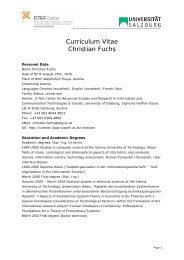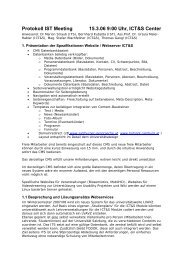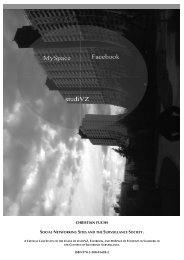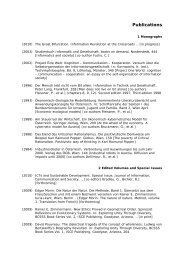ICTS AND SOCIETY: THE SALZBURG APPROACH - ICT&S
ICTS AND SOCIETY: THE SALZBURG APPROACH - ICT&S
ICTS AND SOCIETY: THE SALZBURG APPROACH - ICT&S
Create successful ePaper yourself
Turn your PDF publications into a flip-book with our unique Google optimized e-Paper software.
ICTs and Society: The Salzburg Approach<br />
plicable, can according to Stokes seen combined in the researcher Louis Pasteur.<br />
Stokes exemplifies his ideas of research in the model below, the “Pasteur’s Quadrant”<br />
(see Figure 1):<br />
Quest for<br />
fundamental<br />
Understanding?<br />
Consideration of Use?<br />
NO YES<br />
YES Pure Basic Research<br />
(Bohr)<br />
Use-Inspired Basic<br />
Research (Pasteur)<br />
NO Pure Applied Research<br />
(Edison)<br />
Figure 1: “Quadrant Model of Scientific Research“ (see Stokes 1997, 73).<br />
Pure Basic Research in the upper-left cell refers to grounded research with the primary<br />
quest for fundamental understanding; this can – according to Donald Stokes -<br />
be exemplified with the physicist Niels Bohr: “Niels Bohr’s quest of a model atomic<br />
structure was a pure voyage of discovery“ (Stokes 1997, 73). The right cell below<br />
refers to the kind of research that is (more or less) targeted to concrete application<br />
and production without gaining a deeper understanding for basic questions;<br />
this type of research – dedicated to Thomas Edison – is “[…] extremely sophisticated,<br />
although narrowly targeted on immediate applied goals“ (Stokes 1997, 74).<br />
The left cell below is in reality not empty. It is drawn upon research that is neither<br />
basic, nor applied: “This quadrant includes research that systematically explores<br />
particular phenomena without having in view either general explanatory objectives or<br />
any applied use […]” (Stokes 1997, 74). Stokes mentions private interest in ornithology<br />
as an example for this kind of research. The heart of this model can be found<br />
in the upper right cell, which Stokes dedicates to the chemist Louis Pasteur: “The<br />
upper right-hand cell includes basic research that seeks to extend the frontiers of<br />
understanding but is also inspired by consideration of use” (Stokes 1997, 74).<br />
Also Juergen Mittelstraß addresses this problem. He points out that contemporary<br />
research builds a triangular model assembled by pure basic research, application<br />
oriented basic research and product-oriented applied research (see Figure 2). Hence<br />
the dualism between basic and applied research has – according to Mittelstraß – already<br />
become obsolete (see Mittelstraß 2001, 48-49). Research on stem cells for<br />
example is according to Mittelstraß both, basic research because it is a rather<br />
young discipline and not much knowledge has already been gained, and applied research<br />
because it is product-oriented research (see Mittelstraß 1992, 63).<br />
Hofkirchner | Fuchs | Raffl | Schafranek | Sandoval | Bichler 10









